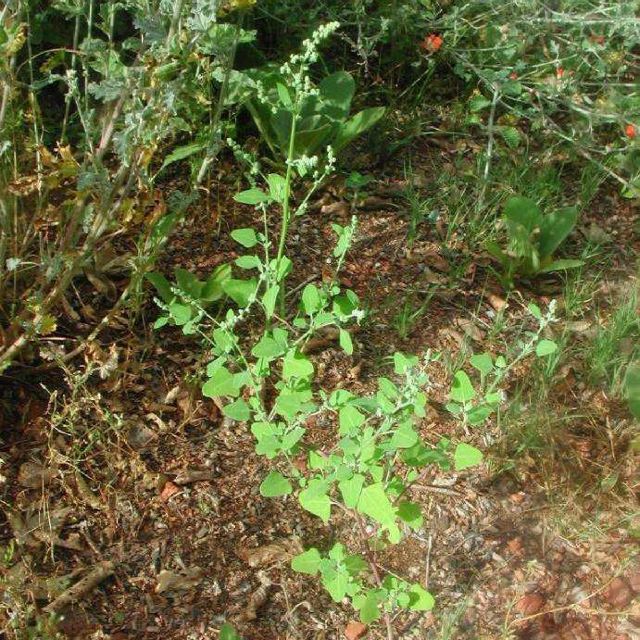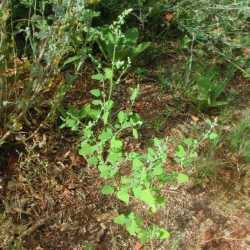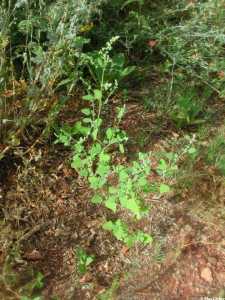Stems erect to spreading, simple proximally, branched distally, 1-8 dm, farinose. Leaves non-aromatic; petiole 0.4-2.5 cm; blade usually broadly triangular, sometimes ovate to elliptic, 0.7-6 cm thick, base truncate or cuneate, margins entire or with a pair of basal teeth or lobes, apex rounded to obtuse, farinose abaxially. Inflorescences glomerules in terminal and axillary interrupted spikes, 16-22 × 4-5 cm; glomerules 2-5 mm diam., maturing mixed; bracts small, margins entire. Flowers: perianth segments 5, distinct nearly to base; lobes ovate, 0.7-1 × 0.5-0.9 mm, apex obtuse, carinate, farinose to subglabrous, completely covering fruit at maturity; stamens 5; stigmas 2, 0.2-0.5 mm. Utricles ovoid; pericarp nonadherent, warty-smooth. Seeds round , 1-1.3 mm diam.; seed coat dark reddish brown to black (sometimes with light streaks), ± smooth. 2n = 18.
Fruiting late summer-fall. A wide variety of habitats from desert, cliffs, talus, and moist shaded areas under aspen, junipers, or pinyons, often in riparian habitats; 2000-2900 m; Alta., B.C., Man., Sask.; Ariz., Calif., Colo., Idaho, Kans., Mont., Nebr., Nev., N.Mex., N.Dak., Oreg., S.Dak., Tex., Utah, Wyo.; Mexico (Baja California, Coahuila, Tamaulipas).
Duration: Annual
Nativity: Native
Lifeform: Forb/Herb
General: Herbaceous annuals, 20-100 cm tall; stems erect and usually branched above; herbage farinose.
Leaves: Alternate, petiolate and non-aromatic; the petioles 0.5-2.5 cm; blades ovate to deltate, mealy below and generally glabrous above, only slightly longer than wide, with the upper portion entire and a pair of teeth or lobes at the base, the lower leaves 3-veined at base.
Flowers: Inconspicuous, green, and clustered, the clusters (glomerules) arranged in terminal and axillary panicles 16-22 cm long; perianth segments 5, farinose to subglabrous, completely covering fruit at maturity.
Fruits: Small ovoid utricles, pericarp nonadherent, warty-smooth; seeds round, 1-1.5 mm, the seed coat dark reddish brown to black, sometimes with light streaks.
Ecology: Found in a variety of habitats from 2,500-9,000 ft (762-2743 m); flowers June-September.
Distribution: Found throughout the intermountain western United States, into the plains, north to Canada and south to Mexico.
Notes: Chenopodium is a genus of usually weedy annual herbs with simple, alternate leaves, herbage that is commonly farinose (with mealy, or floury hairs) to some degree, and clusters of small green flowers lacking petals, which mature into fruits composed of a single seed wrapped in the persistent calyx. C. fremontii is difficult to distinguish in the field from C. incanum and C. neomexicana; very similar to C. album and C. berlandieri also; its absolutely necessary to have mature fruits to ID this group. C. fremontii has triangular leaves with one or two pairs of basal lobes (more teeth or lobes on C. berlandieri and C. album); and single-seeded fruits completely wrapped in a green, densely farinose calyx, the fruits completely smooth, shiny-black and lenticular, without mottling, honeycomb patterns, or a tightly-binding fruit coat (these characters are present in the species listed above). Look for it in Chenopodiaceae in older texts; that entire family is now considered to be part of Amaranthaceae.
Ethnobotany: Cahuilla often eat shoots and leaves, and the Havasupai, Hopi, Navajo and Paiute all use seed flour for bread, porridge or tortillas.
Etymology: Chenopodium is goose foot in Latin, while fremontii is named for John Charles Fremont (1813-1890) an early American explorer.
Synonyms: None
Editor: SBuckley 2010, FSCoburn 2015, AHazelton 2015





